The Watson Microsystem 70
microscope was introduced in the mid 1960's, it is a modular design
with many options, coming in
several
variations of stand from basic none Kohler 'student' all the way up to
the
Hilux 70 with substantial 100
watt external halogen illumination and automatic exposure camera system
designed for serious laboratory work. In this
review I consider whether Watson have carried over 100 years of
mechanical and optical expertise into a well designed microscope or
whether compromises have been made and costs cut to allow sales in an
ever more crowded environment with models from Zeiss, Leitz et al of
the same period.
These microscopes come up quite frequently on eBay and the great thing
is they are usually cheap, in the order of £120
to £200, this one cost £132 and will typically buy
you a
specification similar to
the one shown below making it a possible choice on a short list for
anyone
starting out in microscopy with the student models or experienced user
who wants to add another
stand with the better specified System 70's or Hilux 70, the latter
will more likely to attract higher prices however.
The model here is
middle of the range with a 30 watt lamp,
Kohler illumination, well corrected 'dual disk' achromatic NA 0.90 dry
phase condenser, 4 objective turret [excellent feel on rotation] with 3
phase objectives and
binocular head with 1.5x magnification. The typical student model would
be a monocular and simple illumination whilst the top of the range a
much more bulky affair, typical examples are shown from copies of the
original literature a bit later...
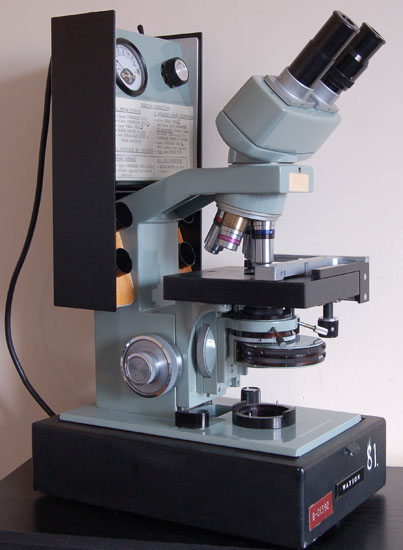
Typical Watson System 70 phase microscope.
Above, Watson Microsystem 70
microscope with phase option bought by the author, notice the large thumb wheel sub stage
height control, which Watson note is designed to be used with the two thumbs while the fingers are on the coarse / fine focus.
This works smoothly but personally prefer the more conventional knob design acting on a rack and pinion. There are receptacles for phase telescope etc placed within the large
metal enclosure housing the power supply, the latter can be removed
independently
however. The deep base makes the binocular head quite high off the
table and
I needed a cushion on the chair to bring me to the right height for
comfortable viewing.
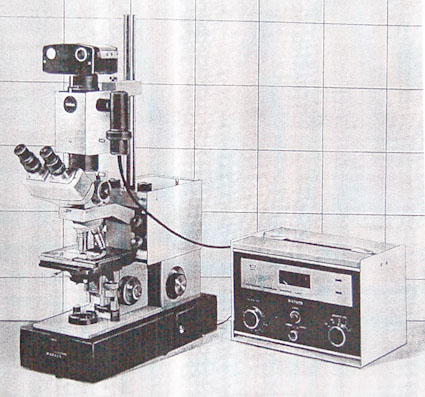
Hilux 70 with 100 watt halogen lighting and camera options.
(Source: Little Imp CD 'Watson Microsystem 70 Photographic Equipment' brochure.)
Watson Hilux
70 fitted with additional base housing the 100 watt illumination with
typical camera
attachment [7 different bodies were available] together with automated
exposure system using the
accessories shown. The size and weight would place it along side the
larger stands from Zeiss and Leitz of the same period such as the Zeiss
Photomicroscope series.
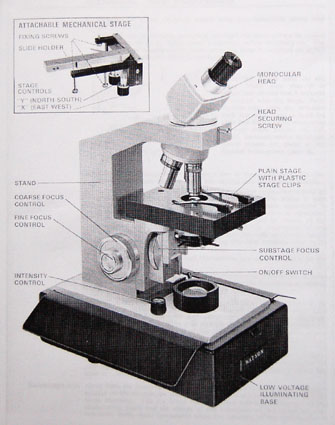
Student version of the Watson Microsystem 70.
(Source: Little Imp CD 'A Handbook for Watson Microsystem 70' brochure.)
Clean lines of the monocular
version of the System 70 fitted with Abbe
condenser [option of adding simple phase attachments], the mechanical
stage along side many
other options would bring it up to a better specified stand. The basic
components like limb and focus block are the same throughout the
complete range. Note the monocular head is supplied with an external
securing screw, this was not fitted on my stand. The none Kohler
lighting base would limit the practicality for more serious work but
even the bases are interchangeable in the System 70 so you could
upgrade
to Kohler. The 'flip-down' hand supports shown here were missing on my
stand.
The Watson literature relates to a number of innovations in the design
and that components have been 'life tested' for durability with wear
compensation in key areas like the main focus block, this is
born out with the latter with excellent feel being not too stiff and of
a
'fluid action', it is a pleasure to use with zero play using the 90x oil
immersion objective after no doubt many hard years being used in the
laboratory.
The coarse focus uses principles based on many years of improvements in
this area and is user adjustable for tension whilst the fine focus is
achieved by "twin beryllium copper spring parallelogram with no sliding
parts giving a rigid hysteresis free movement".
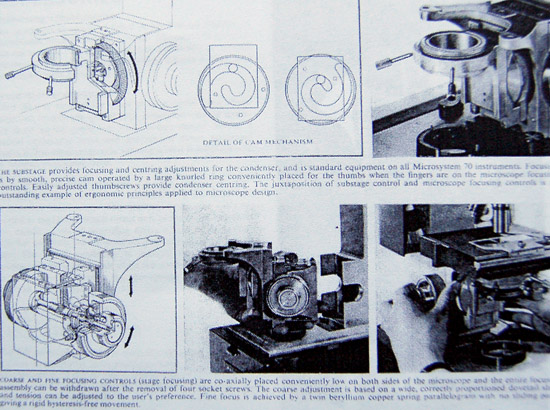
Details from the Watson illustrated guide showing schematics of parts.
(Source: Little Imp CD 'Watson Microsystem 70 Illustrated Guide' brochure.)
The above picture is from the
sales brochure giving details of some of the parts like the removable
focus block and cam mechanism used in the sub stage height control.
Rather than rack and pinion which is almost universally adopted in
research microscopes Watson came up with a space saving rotary control.
I don't like it although I guess, as always, it is down to personal
preference.
Overview.
The heavy [boxed weight
14Kg] Kohler microscope comes in
a sturdy but light weight tall wooden box [approx 7x11x20 inches w.d.h]
with carry handle shown
below, this
houses the stand and removable power supply which rests on the back of
the limb by gravity and a large locating pin fits in the respective
hole in the back of the limb, this makes for a neat system with
relatively small footprint. The Kohler illumination is housed in a
substantial base whilst the bottom panel can easily be removed for
maintenance, two points on the base accept the lever operated catches
housed on the
bottom edge on the front and rear of the lid. Paintwork of the
microscope is 'battleship
grey' and well finished being smooth and silky.
The binocular head is
of compact design and can be rotated but not easily removed as there is
no
thumb screw rather a recessed Allen bolt. No dust can enter at any
point when the binocular head is in situ as all the optics are well
shrouded and the inter-ocular distance
easily set by pulling each end of the slide, calibrations are provided
as usual. The stage which appears to be vulcanite or similar can either
be 'plain' with plastic stage clips, a retrofit attachable slide
carrier fixed with 3 Allen bolts or stage with integrated concentric X
Y drop
down type. The field iris is housed in the base similar to some of the
later Leitz models.
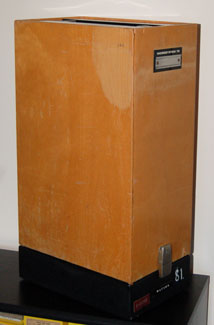
Neat case with handle.
A slim well made case makes
for a neat appearance, you can imagine many of these sat side by side
along laboratory benches in the mornings ready for all the students to
arrive, quick release catches makes handling straightforward although
caution must be used pulling the case clear not to snag on any parts of
the microscope. This one is labeled No.81 so part of a large
consignment.
Sub stage components.
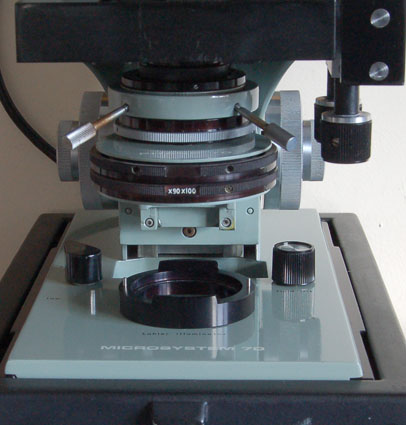
Detail of under stage.
The above photograph shows a
close up of the under stage and base, the large field lens which can
house square colour or polar filters easily comes off on locating pins
which for transport by post makes it a necessity to tape it down or
remove and pack, this one wasn't and could have caused much damage in
transit to objectives or paintwork, thankfully it didn't! The lever on
the left of the base actuates a swing in auxiliary lens for the Kohler
system for objectives 20x - 100x. The knob on the right of the base
actuates the field diaphragm similar to some Leitz and Leica designs. A
centering
sub stage houses the condenser, note the two rings on the condenser,
the
top is for all dry objectives, the bottom for oil immersion. It is
unusual and unlike Zeiss in that the condenser iris is still in the
light path at all times and must be adjusted to suit for phase
operation. There are
'blank' positions in upper and lower disks to allow for correct setting
for each objective range. Just below the centering screws there is the
rather narrow condenser diaphragm control, although large in diameter I
found
this not as convenient as those with a long arm, the latter easier to
adjust and grip, especially when the control is partly hidden in normal
operation. The slots at the edge of the base are to accept hand rests
which are missing on this stand.
Note the substantial aluminum coarse focus controls which are based on
standard rack and pinion in operation, these actuate on the stage not
the limb. The fine
focus system is 'sprung' to allow for wear take up and provides
excellent
'feel' at all magnifications. The condenser is not 'quick release' like
many microscopes although can be removed if required, the idea being
you specified the desired condenser
from Watson when ordering. They made a simple 2 element Abbe, 5
element achromatic shown [option of long working distance] and an
oil immersion zonal dark field to
be used with 90x or 100x objectives whose apertures have been reduced
to NA of 1.0 using stops although this could be used for circular
oblique illumination.
Watson say in their literature that the achromatic NA 0.9 is
perfectly adequate for their oil immersion objectives. It is very well
corrected for both spherical and chromatic aberrations. Small Allen key
points set the centering of the phase annuli, [the phase outfit would
originally have contained a small hex adjuster missing here], on this
stand no
adjustment was required. No filter tray is supplied with the achromatic
condenser which prevents much experimentation with home made Rheinberg,
circular
oblique or
other contrast techniques. Oblique illumination can be still applied by
offsetting the brightfield port on the condenser, or movement of an opaque card
say on the
field lens and circular oblique on the 40x objective by using the 100x
phase annuli whilst dark-field can be applied to the 10x objective
using the same technique.
Phase outfit.
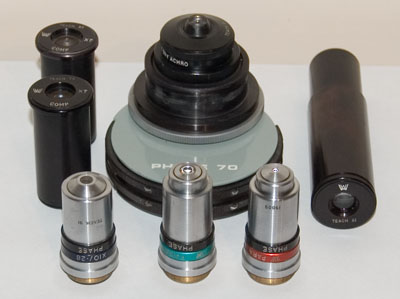
Phase outfit shown with 3 'Para' achromatic objectives. Positive and negative phase objectives were available.
Watson note that the phase plates are deposited on an optical element rather than use an additional glass plate.
A close up of the condenser
and unassuming 'Para' phase objectives, a simple 'short' 5x 'Para' is
also included in the set which is not shown here and on this sample
needed an extending collar to make it roughly par-focal with the rest
of the range. The phase range shown are 10x NA 0.28, 40x NA 0.70 and
oil immersion 90x NA 1.30, the extra NA compared to many typical phase
achromats provides a crisp clean look to phase with reduced
'shadowing' at the edges of
prepared diatoms and little colour abnormalities.
The 7x compensating
eyepieces should be used with objectives 20x and above and none
compensating Huygenian below this, this is verified in taking
photographs using a Sony P200. With the binocular head 1.5x factor this
together with the supplied eyepieces gives 10x overall magnification.
Watson did 'field' tests between parallel tube binocular and inclined
binocular tubes asking how much strain the users had over continued
use, the result was that most preferred the inclined so this was
adopted.
The objective line up for the System 70 are 8 Parachromatic, 2
Planpara, 3 Fluorite and 3 Apochromatics with 7 phase variants so a
good
number to choose from. The Parachromatic 5x is reasonably plan whilst
all of the phase objectives tested here give bright detailed images, my
favourites being the 40x using circular oblique illumination [see
later] with green
or pale blue
light and the 90x phase which gives excellent results. A total of 18
different eyepieces were available!
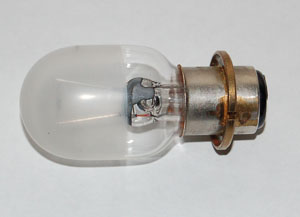
Phase bulb with light frosting.
The 6 volt 30 watt bulb comes
in two types, clear and slightly frosted, the latter is designed for
phase use where any filament abnormalities in the light path where
reduced, my stand you can still see residual filament 'lines' in the
field of view clearly picked up by camera, so only a partial success?
This
is as true to original Kohler you will find in any microscope and puts
some modern research stands to shame pertaining to be
of 'Kohler' design one of which I know has not one but two strong in
line
diffusers permanently in the light path.. however, the use of diffusers
in the light path reflects the wide field of view eyepieces of today
and small filament area of halogen bulbs compared to custom made
tungsten bulbs and narrower field of view eyepieces of older designs.
The only diffusion is on the
phase bulb and then if you order the clear version through the whole
light path there are no diffusers. This has to be highly commended and
shows how well Watson implemented the source illumination and
condenser, it is pretty obvious the optics have been well chosen and
researched. Remember there is no swing out element on the condenser
only an auxiliary lens in the base for objectives above 20x. The
ceramic bulb
holder is pre-centered at the factory and collar on the bulb provides
accurate centering within the holder, sadly on this one the solder had
deteriorated and the collar had to be re-made. A rather fiddly metal
plate holds the bulb securely in place acting against strong sprung
bulb
electrical contacts.
Inside the Kohler base.
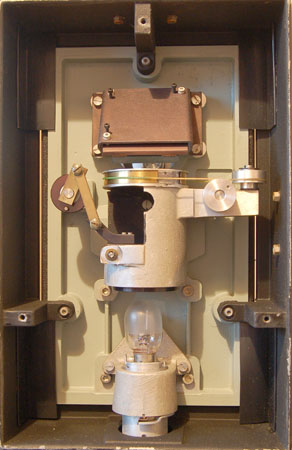
Detail of Kohler base with cover removed.
A simple clean design in the
base, the lever operated control on the left half way up is for the
swing out auxiliary lens and in the center, the large drum operated by
chord similar to design from 1960's transistor table radios is for the
field iris, this has plenty of leaves although in use at high
magnifications where the aperture is very small looks rather 'ragged'
in the field of view.
The large housing at the
top holds the substantial mirror reflecting the light source up through
the field lens attached on the top panel. All the metal work is
substantial, well finished and simple in operation which should give
many years of life. The Kohler base uses a total of 4 optical elements
with the auxiliary lens in situ. The bulb is mounted in a bayonet fitting on the base back plate allowing easy bulb replacement without removing the base.
Other none Kohler variations are the mains voltage illumination base
with 25 watt 100-120v or 200-250v ac diffused light and the low voltage
base with 6v 18 watt bulb with rheostat built into the base.
The power supply.
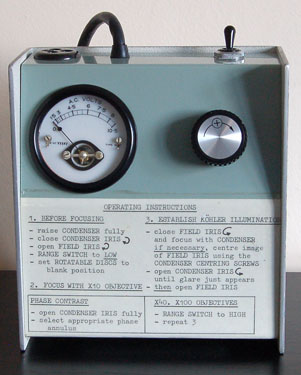
Power supply with rheostat and meter.
The power unit normally rests
via a large locating pin onto the top of the limb, I am not certain I
like this but least it keeps all the parts together! It doesn't come
much simpler with a rheostat and a rather quaint moving iron ac meter.
The toggle switch for the 240 v ac mains can be seen on top together
with the 3 way special socket to accept the mains, a rather
inconvenient location I thought with the lead drooping down. The short
thick cable seen at the top takes the variable low voltage to the bulb
in the base. Laboratory instructions have been left on being part of
its history! The unit is very easy to work on as shown below.
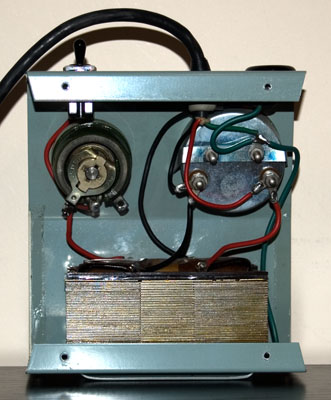
Detail of power supply with cover removed.
Underside of power supply,
very simple operation with mains transformer feeding a good quality
ceramic based rheostat with
the meter indicating the working volts. This one had a modification to
prevent operation above 6v by using a large wire wound resistor
soldered in line with the rheostat to prevent bulbs being
blown.. I guess by possible careless operators. This has been removed
and
restored to the original condition. Occasionally it is desirable to
overdrive the bulb by a small percentage specially for high power
phase. The rheostat turns were dirty as shown here causing
fluctuations in light intensity but after a clean this was improved
somewhat but not completely.
Mechanical stage.
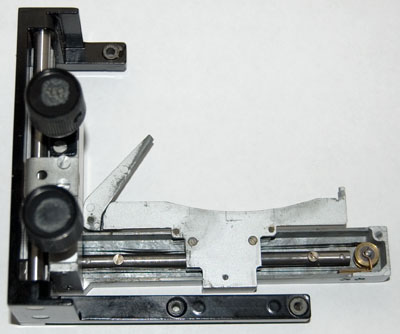
Underside of bolt on stage controls.
This is the add on X Y control
which can be retrofitted to plain stage with clips. It is attached by 3
large bolts with Allen key heads, although Watson describe this as an
innovative design I came to dislike it with a passion when trying to
refurbish it. As received the X control was lumpy and the Y control a
rather frightening 'jump' to the right of objects occurred at anything
above 10x. Whilst the rest of the microscope is well finished this
didn't look up to the same standards being rather crude.
It does prevent the typical protrusion you get from a rack and pinion
design and I guess the wooden case gave Watson a 'headache' with its
close fit when being brought down to be clipped to the base so
the rack and pinion design was probably ruled out.
Here it shows the unit before being refurbished, it comes apart fairly
easy, 2 screw heads can be seen on the horizontal X shaft these are the
'stops' to prevent too much travel. The mechanism relies on a friction
coupled metal 'tape' running around a rotating rubber guide [hidden on
the left] and the other end a 'sprung' rotating brass guide, seen above
right,
this gives the tension. The problem is the metal tape if removed
has a tendency to twine itself in knots, is easily creased, flimsy and
hard to work
with. The friction if
too loose between the brass X drive shaft and the rubber guide [there
is no anchorage it is just a push on fit] leaves the X control stranded
some where along its travel so any muck or oil that has creeped in
could cause problems, I had to dismantle and clean. The springy
copper alloy fingers holding the brass guide seen on the right above
had to be re-tensioned which
caused all sorts of problems. After spending hours of frustration I
finally managed to get a working unit and all the work paid off with
both the X and Y smooth in operation but for such a simple system it is
very annoying to work on. I didn't dismantle the Y control working as
best as I could cleaning parts in situ. Even this gave me a headache as
there is control to set the angle of the slide carrier to
prevent binding and scraping of the stage and is a combination of a
metal plate with two screws and nylon adjustable grub screw but I got
there in the end!
Some pictures.
A few images are shown below,
the first, a crop of a human flea taken with the 5x objective using a
hand held Sony P200 digital camera at the eyepiece.
The remaining three are two types of diatoms from a Klaus Kemp 8 form
test plate [Stauroneis phoenocenteron and Navicula lyra]
using a 1.3Mp Opticstar CCD camera in place of the eyepiece. Good
detail and considering the Para's are not described as plan objectives
give a competent flat field image. No additional sharpening has been
applied post re-sizing.
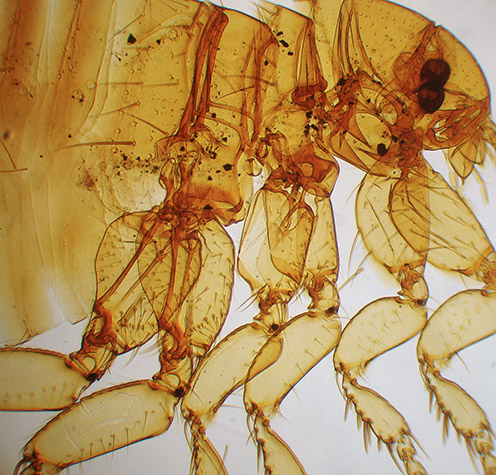
Part of a human flea. 5x NA 0.12 Para objective.
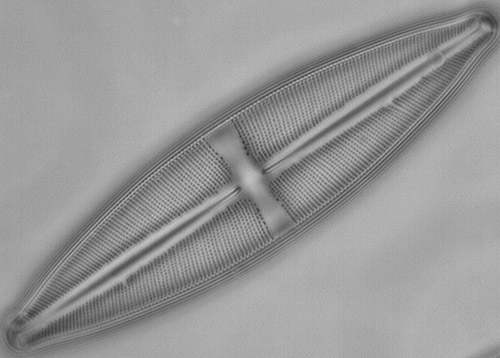
40x NA 0.70 Para. Circular oblique using the 100x phase ring.
This is a powerful combination and ideal for e.g. diatom studies, utilising almost the full NA of the objective.
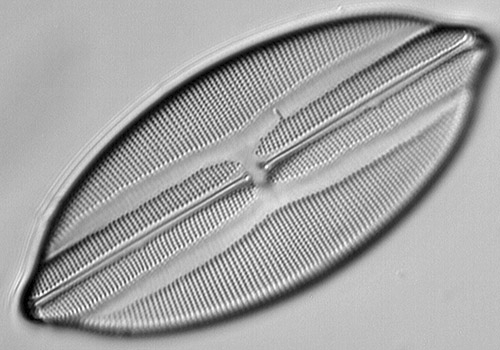
40x NA 0.70 Para. 50% oblique lighting using the offset brightfield port
in the phase condenser.
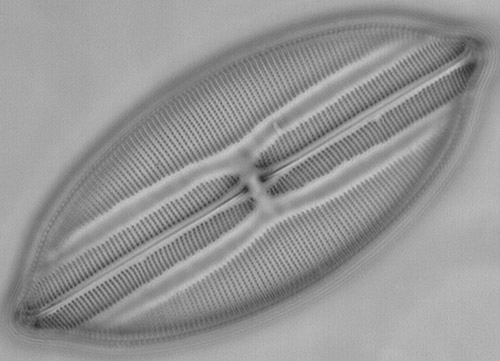
40x NA 0.70 Para. Circular oblique using the 100x phase ring, 'black dot' focus.
Conclusion.
I would say having used a number of other microscopes of several
vintages over the years the Watson Microsystem 70 is on the whole very
competent, although
not the most elegant of microscopes it has on the plus side..
1. Cheap to buy and add to.
2. Good optics, quality achromatic phase
condenser and objectives option being notable.
3. Excellent coarse and fine focus [at least on this stand], which
should remain that way for years.
4. Good overall build and finish.
5. Relatively small footprint and tidy with the wooden case supplied.
Against,
purely from personal operational preference is the sub stage height
control,
to a lesser degree the condenser iris adjustment and add on stage
mechanics. Only 2 plan objectives are offered, 4x and 40x
achromats so some photography will be limited although if parfocality
is not an issue plan objectives from other makers could be used.
Comments to author are welcomed.
Resources and Acknowledgements
Further information is available on the series of 'Little Imp' CDs produced by Mike Samworth and Steve Gill; see the Savona Books U.K website. The 'Watson Microsystem 70' CD is £4, (Savona catalogue number M82). This provides a wealth of information on the Watson Microsystem 70 and Hilux 70 including brochures, original prices of the time, operation manuals, accessories, including phase, eyepieces and objective range, also a journal review of the microscope. There is little I could find on the Internet about the System 70 other than this excellent resource and Mike and Steve must be commended for assembling such useful information. The scans from the maker's literature in the article are from the CD and shared with thanks and permission from Mike Samworth and Steve Gill.
Little Imp have carefully compiled a wide range of CDs of often hard to source older literature on a wide variety of topics, including makers literature, papers and public domain books; for further details see the Savona Books website.
Once again Klaus Kemp's 'Test plate 8 forms' diatom slide proved to be an invaluable slide for setting up and using a microscope both visually and for imaging. This and his other slides are available from www.diatoms.co.uk
Microscopy UK FrontPage
Micscape
Magazine
Article
Library
© Microscopy UK or their contributors.
Published in the December 2009 edition of Micscape Magazine.
Please report any Web problems or offer general comments to the Micscape Editor .
Micscape is the on-line monthly magazine of the Microscopy UK website at Microscopy-UK .
© Onview.net Ltd, Microscopy-UK, and all contributors 1995 onwards. All rights reserved. Main site is at www.microscopy-uk.org.uk .